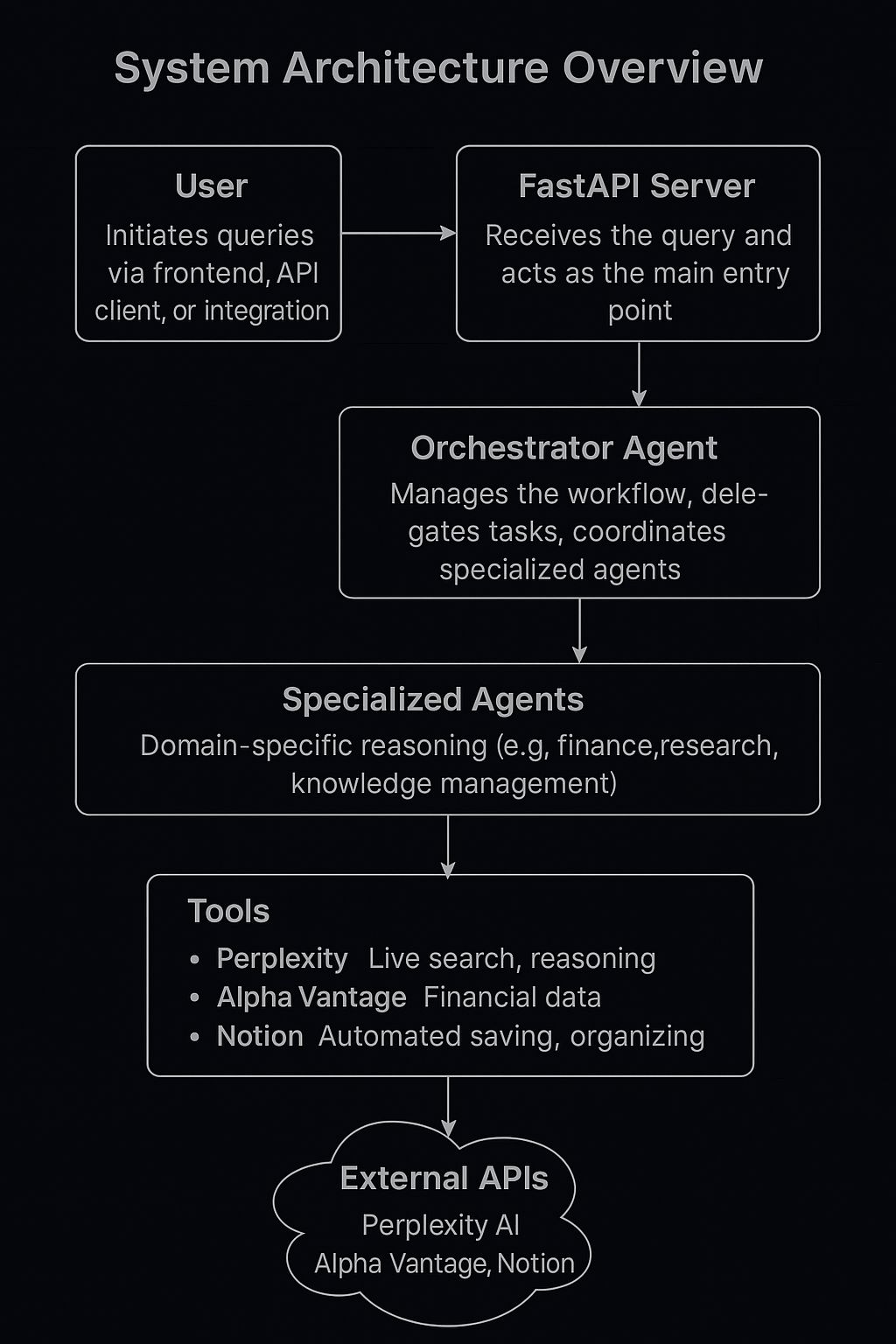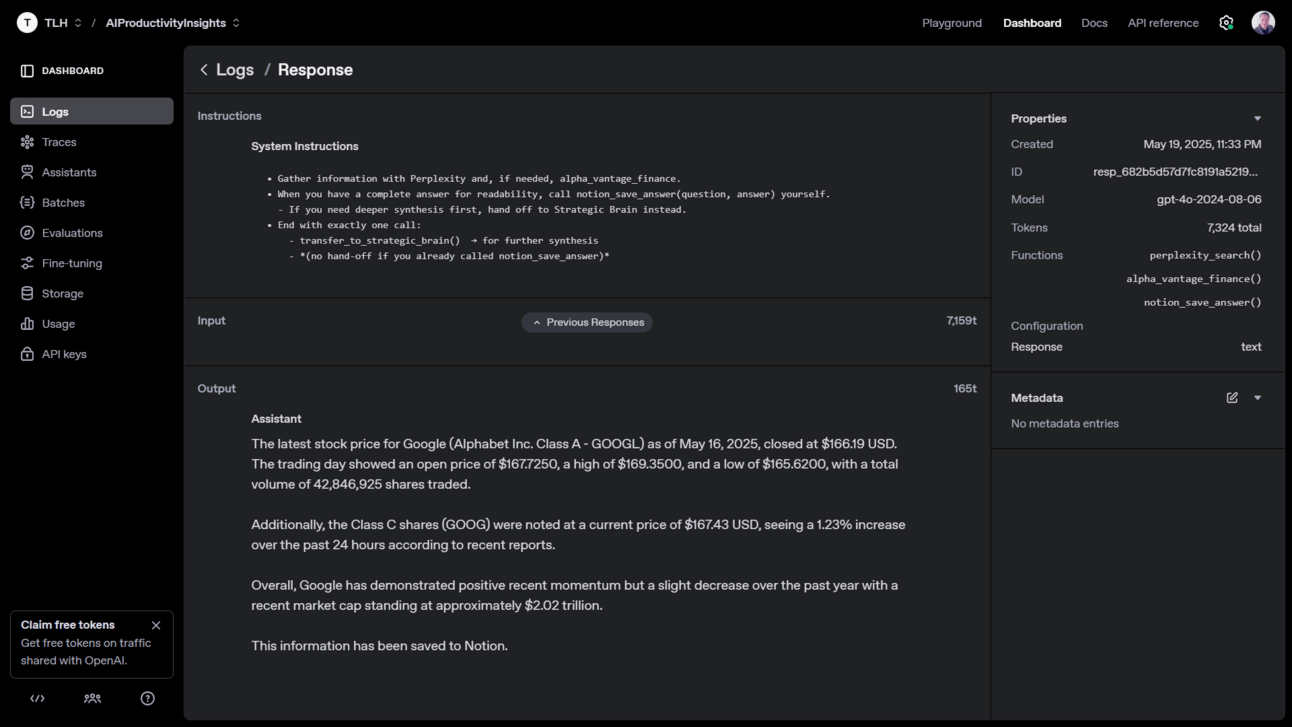Reading Time: 10 min ⏱️
Introduction
While the future of multi-agent AI is rapidly moving toward standardized protocols like MCP (Model Context Protocol), today’s most accessible and robust approach for real-world agent orchestration remains the proven FastAPI HTTP pattern. In this edition, we provide a step-by-step guide for implementing a multi-agent server using the OpenAI Agents SDK—leveraging FastAPI for API endpoints, Perplexity AI for live market insights, Alpha Vantage for financial data, and Notion for automated knowledge management.
You’ll learn how to design modular agent pipelines, expose their capabilities over HTTP, and integrate them seamlessly into your existing applications or business workflows. Whether you’re building a productivity tool, data analytics backend, or LLM-powered automation engine, this guide equips you to deliver practical, scalable agentic AI with technologies you can use right now.
1. Why OpenAI Agents SDK with FastAPI?
The OpenAI Agents SDK provides a modular framework for building, orchestrating, and extending AI-powered workflows with large language models (LLMs). When paired with FastAPI, it enables you to deliver agentic intelligence as scalable HTTP services—ready for real-world integration.
Key Advantages
Composable Tooling
Easily create and expose Python functions as agent tools. With a simple decorator, any Python method becomes callable by your AI agents—streamlining the connection between your business logic and LLM reasoning.Multi-Agent Coordination
Design complex workflows where agents can collaborate, delegate, and specialize using handoffs. This modular architecture allows each agent to focus on a domain—enabling sophisticated reasoning and automation across tasks.External API Integration
Instantly connect your agents to best-in-class external services, including Perplexity for live knowledge, Alpha Vantage for financial data, and Notion for knowledge management. FastAPI’s async capabilities ensure these integrations are fast and reliable.HTTP Endpoint Exposure
With FastAPI, you make your agents and workflows accessible over standard HTTP endpoints—enabling easy integration with apps, webhooks, and other platforms.
Core Components
Agents
Autonomous, LLM-driven modules with specific instructions and toolkits, designed to solve targeted tasks or handle specific data sources.Handoffs
Smart delegation flows, allowing one agent to transfer context and control to another, based on expertise or workflow needs.Guardrails
Built-in safety layers on both input and output, enforcing type, schema, and business logic validation—minimizing errors and ensuring robust automation.Tracing
End-to-end diagnostics and visibility, with real-time logs for every agent step and tool call. This makes debugging and optimizing workflows straightforward.
“The OpenAI Agents SDK lays the groundwork for agentic AI systems that are both modular and scalable—perfect for building robust, enterprise-ready AI workflows. Paired with FastAPI, it empowers you to build multi-agent AI systems that are modular, testable, and ready for immediate deployment in any modern tech stack.”
2. System Architecture Overview
A modern multi-agent AI workflow is more than just language models and API calls—it’s a coordinated pipeline where agents, tools, and external services work together to turn user queries into actionable results. The architecture below demonstrates how FastAPI, the OpenAI Agents SDK, and best-in-class external tools fit seamlessly into this pipeline.

High-Level Workflow Components
User: Initiates queries via a frontend, API client, or integration.
FastAPI Server: Receives the query and acts as the main entry point.
Orchestrator Agent: Manages the workflow, delegates tasks, and coordinates specialized agents.
Specialized Agents: Handle domain-specific reasoning (e.g., finance, research, knowledge management).
Tools: Python functions or integrations enabling agents to call external APIs and services.
Perplexity: Live search, reasoning, or contextual knowledge.
Alpha Vantage: Real-time or historical financial market data.
Notion: Automated saving and organizing of insights and structured outputs.
External APIs: Perplexity AI, Alpha Vantage, Notion integration.
Step-by-Step: How a User Query Flows Through the System
User sends a query (e.g., “Summarize the latest Apple stock price and save to Notion”) to the FastAPI endpoint.
FastAPI receives the request and hands it to the Orchestrator Agent for processing.
Orchestrator Agent analyzes the request and decides which specialized agent(s) and tools are required.
Specialized Agents (such as “Knowledge Digger” for data gathering or “Strategic Brain” for synthesis) invoke the relevant tools:
Use Perplexity to search and summarize the latest news.
Call Alpha Vantage for live financial data.
Agents collaborate as needed, handing off intermediate results for deeper reasoning, validation, or synthesis.
Once the answer is complete and structured, an agent uses the Notion tool to save the final output into a Notion workspace for easy retrieval and collaboration.
FastAPI returns the final response to the user, confirming success and providing any requested details (such as a link to the new Notion page).

Figure: Example of a financial report for Google, automatically generated by your pipeline and presented in Notion.
3. End-to-End Implementation Walkthrough
This section shows you, step by step, how to set up a business-ready, multi-agent FastAPI server that turns user queries into professionally formatted insights—saving the results directly to Notion.
Step 1: Generate Your OpenAI API Key
Step 2: Create Your Perplexity API Key
Step 3: Register for Your Alpha Vantage API Key
Step 4: Configure Notion Integration
Step 5: Build Your FastAPI Server and Client
Step 6: Run and Test the Pipeline Demo
4. Real-World Lessons from Building Multi-Agent AI Pipelines
1. Orchestration Overhead is Real
Coordination between agents adds latency—each agent handoff, tool call, and external API integration introduces delays.
Batching or parallelizing tool calls (where possible) can help mitigate slowdowns.
2. API Rate Limits and Reliability
Many third-party APIs (Perplexity, Alpha Vantage, Notion) enforce rate limits or may be intermittently slow.
Robust error handling and retries are essential for reliability in production.
3. Environment and Secret Management
Changing API keys or database IDs can cause confusing “stale state” issues if not managed carefully—always validate environment variables at runtime and restart servers after changes.
4. Output Formatting is Key for Readability
Raw LLM/API outputs are rarely presentation ready.
Post-process with an LLM step (like
openai_llm_tool) to ensure results are business-friendly and human-readable.
5. Permissions & Integration Sharing
Notion integrations must be explicitly shared with each target database/page—missing this step leads to “database not found” errors.
6. FastAPI’s Simplicity Makes Iteration Easy
Hot-reload with
uvicorn --reloadaccelerates development.FastAPI’s request/response models make debugging input/output trivial.
7. Trace and Debug Early
Enable detailed tracing/logging during development.
OpenAI’s trace tools and custom FastAPI logs are invaluable for debugging agent workflows and performance bottlenecks.

Figure: OpenAI’s trace tools

Figure: OpenAI’s log tools
5. Conclusion & Resources
Recap and Key Takeaways
In this edition, we’ve explored the practical realities of building a modern multi-agent AI workflow using FastAPI and the OpenAI Agents SDK, integrated with data sources like Perplexity and Alpha Vantage, and knowledge management through Notion.
By leveraging modular agents, robust orchestration, and strong output formatting, you can deliver actionable, business-ready insights with minimal custom code and rapid iteration cycles.
Key takeaways:
Agent-based design makes complex workflows manageable, scalable, and easy to debug.
FastAPI provides a clean, testable entry point for HTTP clients and other AI applications.
Output formatting and tracing are critical for high-quality, reliable production systems.
Attention to environment management, API quotas, and integration permissions is essential for smooth deployment.
Where to Go Next
OpenAI Agents SDK:
GitHub Repo & Docs
Quickstart GuideModel Context Protocol (MCP):
Official DocumentationPerplexity API:
API DocsAlpha Vantage API:
API Docs & KeysNotion Python SDK:
notion-sdk-pyStarter Templates:
OpenAI Agents SDK Example Templates
Stay Connected
If you have questions, want to share your own implementation stories, or have suggestions for future editions, I’d love to hear from you! Reply directly to this newsletter or reach out via LinkedIn
Subscribe to AI Productivity Insights for free and receive the latest developments in AI integration patterns, implementation guides, and industry best practices. Our newsletter delivers curated insights to your inbox, helping you stay at the cutting edge of AI innovation while working smarter, not harder.

